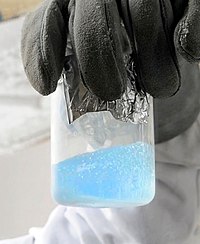
Photo from wikipedia
Reactive oxygen species (ROS) are strong oxidants, and have attracted considerable attention in both biological and environmental fields. Although various methods for ROS detection, including optical and electrochemical techniques, have… Click to show full abstract
Reactive oxygen species (ROS) are strong oxidants, and have attracted considerable attention in both biological and environmental fields. Although various methods for ROS detection, including optical and electrochemical techniques, have been developed, they still face challenging issues in terms of poor sensitivity, reproducibility, stability, and in vivo applicability. Here, we present a sensitive and selective optical sensor for ROS detection, based on single plasmonic nanoprobes and redox-active cytochrome c (Cyt c)-mediated plasmon resonance energy transfer. By measuring the spectral changes of plasmonic nanoprobes, derived from the unique molecular absorption of Cyt c in accordance with the redox state, calibration curves for H2O2, a representative ROS, in various media were obtained over a wide concentration range from 100 mM to 1 nM. Limit of detection and limit of quantification in accordance with the used medium were determined from 8.3 to 12.8 nM and from 27.6 to 42.7 nM, respectively. Selectivity coefficients for major interfering solutes were much lower than 0.1 indicating a good selectivity for ROS. From the dynamic spectral changes, we sensitively monitored ROS generated in Caenorhabditis elegans (C. elegans) exposed to graphene oxide. Based on the calibration curves, we also determined ROS levels in various aquatic environments, such as river streams and a small pond, as a way of environmental monitoring. We believe that our approach could provide an avenue for achieving dynamic and sensitive monitoring of ROS in toxicological, biological, and environmental fields in the future.
Journal Title: Analytica chimica acta
Year Published: 2017
Link to full text (if available)
Share on Social Media: Sign Up to like & get
recommendations!